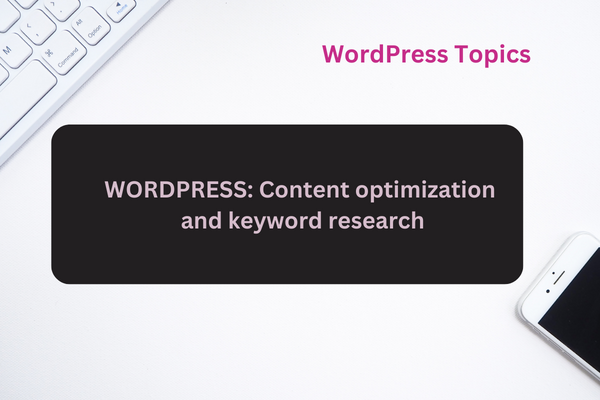WORDPRESS: Content optimization and keyword research
Optimizing your WordPress content for search engines involves several key steps, including keyword research, on-page SEO, and high-quality content creation. Here's a step-by-step guide on how to do it effectively:
Keyword Research:
Start by researching relevant keywords related to your content topic. Use tools like Google Keyword Planner, SEMrush, Ahrefs, or free options like Ubersuggest or AnswerThePublic. Look for keywords with a good balance of search volume and competition. Long-tail keywords (phrases with 3+ words) can be valuable because they are more specific and typically have less competition.
Content Planning:
Plan your content around the chosen keyword(s). Your content should be valuable and relevant to your audience. Create an outline that includes headings and subheadings to structure your content effectively.
Content Creation:
Write high-quality, informative, and engaging content. Aim for a word count that thoroughly covers the topic but doesn't feel overly long or repetitive. Incorporate your target keyword naturally into your content. Avoid keyword stuffing; use variations and synonyms instead.
Use short paragraphs, bullet points, and images to make your content more readable.
On-Page SEO:
Optimize your WordPress title tag and meta description with the target keyword(s). Use a plugin like Yoast SEO or All in One SEO Pack to help with this. Use descriptive, keyword-rich URLs. WordPress allows you to customize the permalink structure. Include internal links to other relevant pages on your website. Optimize your images by compressing them and adding alt text that includes keywords.
Mobile Optimization:
Ensure your website and content are mobile-friendly. Google prioritizes mobile-first indexing. Use responsive design themes or plugins to make your site mobile-responsive.
Page Loading Speed:
A fast-loading website is crucial for SEO. Use plugins like WP Super Cache or WP Rocket to improve page load times. Optimize images, use browser caching, and consider using a content delivery network (CDN) for improved performance.
Quality Backlinks:
Encourage backlinks from authoritative websites in your niche. High-quality backlinks can significantly boost your SEO. Guest posting, creating shareable content, and networking with others in your industry can help you earn backlinks.
Regularly Update Content:
Keep your content up to date by revisiting and refreshing old posts. This shows search engines that your site provides current and relevant information.
Monitor and Analyze:
Use tools like Google Analytics and Google Search Console to monitor your website's performance. Track keyword rankings, organic traffic, click-through rates (CTR), and user engagement.
User Experience (UX):
Ensure a good user experience on your site. This includes easy navigation, clear calls to action, and a well-designed layout.
Remember that SEO is an ongoing process, and results may take time to show. Continuously refine your content and SEO strategies based on analytics data and changes in search engine algorithms. WordPress offers various plugins and themes designed to help with SEO, so make use of them to streamline the optimization process.


Thanks for sharing valuable content.
ReplyDelete